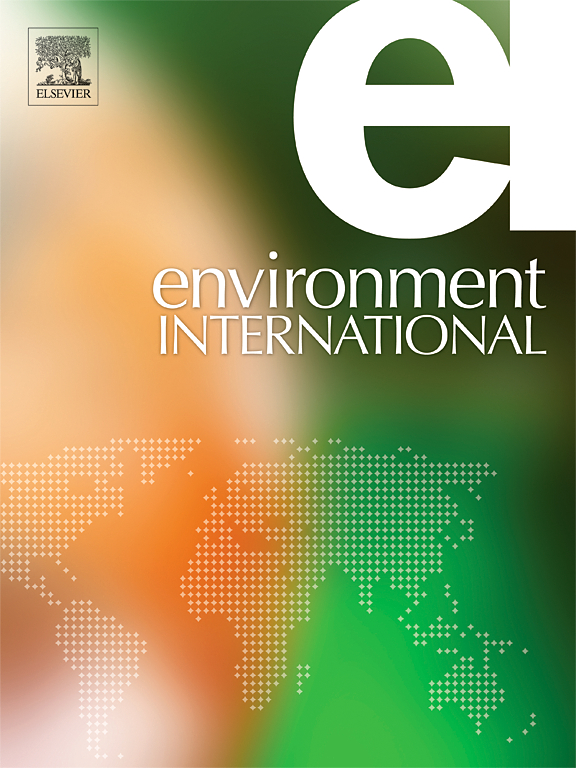Nanoplastics released from textile washing enrich antibiotic resistance and virulence genes in sewage sludge microbiomes
IF 10.3
1区 环境科学与生态学
Q1 ENVIRONMENTAL SCIENCES
引用次数: 0
Abstract
The washing of synthetic textiles is a major source of microplastic pollution, contributing to the widespread presence of nanoplastics (NPs) in wastewater treatment plants (WWTPs). However, the role of laundry-released NPs in shaping microbial communities and facilitating the spread of antibiotic resistance genes (ARGs) and virulence factor genes (VFGs) in sludge remains unclear. Here, we quantified the concentration and size distribution of NPs released during the washing of polyamide (PA), polypropylene (PP), and polyethylene terephthalate (PET) textiles using nanoparticle tracking analysis. Substantial NP release was observed, with concentrations ranging from 3.4 × 107 to 1.7 × 108 particles mL−1, and sizes between 130 and 240 nm. We then evaluated their impact on ARG and VFG profiles, as well as bacterial communities in anaerobic sludge through metagenomic and 16S rRNA gene sequencing. Laundry-released NPs significantly increased the abundance of ARGs, VFGs, and mobile genetic elements (MGEs) in sludge, with D8A-2 and Halomonas identified as potential ARG and VFG hosts. Notably, the mechanisms driving ARG enrichment varied by NP type. PA-released NPs elevated reactive oxygen species levels in bacterial communities, facilitating horizontal gene transfer via MGEs, while PP- and PET-released NPs enhanced ARG enrichment through both horizontal gene transfer and shifts in bacterial community composition. These findings highlight the risks posed by laundry-released NPs accumulating in WWTPs, emphasizing the urgent need for improved wastewater management strategies to mitigate their environmental and public health impacts.


纺织品洗涤释放的纳米塑料丰富了污水污泥微生物群中的抗生素抗性和毒力基因
合成纺织品的洗涤是微塑料污染的主要来源,导致纳米塑料(NPs)在废水处理厂(WWTPs)中广泛存在。然而,洗衣释放的NPs在塑造微生物群落和促进抗生素耐药基因(ARGs)和毒力因子基因(vfg)在污泥中传播中的作用仍不清楚。在这里,我们用纳米颗粒跟踪分析方法量化了聚酰胺(PA)、聚丙烯(PP)和聚对苯二甲酸乙二醇酯(PET)纺织品洗涤过程中释放的NPs的浓度和大小分布。观察到大量NP释放,浓度范围为3.4 × 107至1.7 × 108颗粒mL - 1,大小在130至240 nm之间。然后,我们通过宏基因组和16S rRNA基因测序评估了它们对ARG和VFG谱的影响,以及厌氧污泥中的细菌群落。洗衣释放的NPs显著增加了污泥中ARG、VFG和移动遗传元件(MGEs)的丰度,其中D8A-2和Halomonas被确定为潜在的ARG和VFG宿主。值得注意的是,驱动ARG富集的机制因NP类型而异。pa -释放的NPs提高了细菌群落中的活性氧水平,促进了通过MGEs的水平基因转移,而PP-和pet释放的NPs通过水平基因转移和细菌群落组成的变化增强了ARG的富集。这些发现突出了洗衣释放的NPs在污水处理厂积累所带来的风险,强调迫切需要改进废水管理战略,以减轻其对环境和公共卫生的影响。
本文章由计算机程序翻译,如有差异,请以英文原文为准。
求助全文
约1分钟内获得全文
求助全文
来源期刊

Environment International
环境科学-环境科学
CiteScore
21.90
自引率
3.40%
发文量
734
审稿时长
2.8 months
期刊介绍:
Environmental Health publishes manuscripts focusing on critical aspects of environmental and occupational medicine, including studies in toxicology and epidemiology, to illuminate the human health implications of exposure to environmental hazards. The journal adopts an open-access model and practices open peer review.
It caters to scientists and practitioners across all environmental science domains, directly or indirectly impacting human health and well-being. With a commitment to enhancing the prevention of environmentally-related health risks, Environmental Health serves as a public health journal for the community and scientists engaged in matters of public health significance concerning the environment.
 求助内容:
求助内容: 应助结果提醒方式:
应助结果提醒方式:


